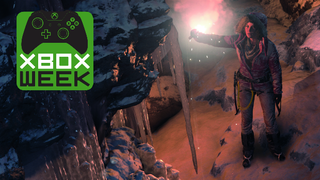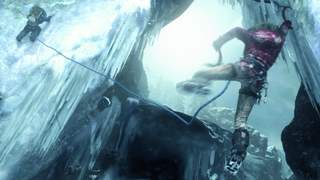Part 4: Tomb with a View
Upon watching the demo, the first thing that hits you – avalanche aside – is how crisp the icy wastelands look. Lara’s initial ice climb is tethered to a linear path, but it’s beautifully decorated: hunting gear freely jangles on her belt, flare light sinks into the cracks between icicles and wading through thick banks of powered snow sees it displaced into mucky trails. Croft herself is impressively reactive to changing conditions, be it pulling her feet from snow piles or hunkering down when walking into a brutal wind. And yes, those ludicrously wafty TressFX hair physics are back, though they take time to warm up, with Lara’s initial ‘do frozen into an icy wodge.
You can see the skeleton of the former game under the shiny details, a result of Crystal Dynamics’ new Foundation engine being built, aptly, on what came before. This isn’t meant as a slight. The reboot was gorgeous and still held its own in 2014’s Xbox One port. But the two share visual DNA, with intensely scripted linear corridors that throw blockbuster effects at the screen and more contemplative hub areas where Lara drinks in the details and goes about exploring. The difference this time? Those hubs are two to three times larger than Tomb Raider’s, which, let us remind you, already gave us entire mountains and sprawling mining outposts to conquer.

Our demo reveals one such hub – a disbanded Soviet facility that incorporates a factory, a small town’s worth of dilapidated buildings, a rail yard and valley-crossing bridge. Just in case any of this is read as unreachable background detail, one of Trinity’s invading goons fires a signal flare from the other side of the valley. Automatically you start planning your route over, eyeing the criss-crossing telegraph wires and the you-could-just-about-make-it gaps between crumbling rooftops.
It’s a shame that, for the sake of this presentation, Lara is left looking down from a distance. Standing still does give the demonstrator a chance to rotate the camera and reveal the shiniest overhaul of them all: Lara herself. Gallagher says character models were a big focus this time round, that “Lara is so prominent on screen, making her spectacular is the goal.” Where the first game strapped cameras to the actors for frame-by-frame reference, ROTTR uses motion capture to map the shifting musculature of the face and better translate actor Camilla Luddington’s emotional state. Even this technology takes a step forward thanks to the Foundation engine.

“The new motion-capture system is actually a spray that goes over the entire face, which gives you something like 7,000 reference points,” says Hughes. “They still wear the dots, but the system scans Camilla’s face, and then maps that to these super-high-resolution versions of her face.” The effort is harder to appreciate, as Lara doesn’t have Luddington’s face, but the actorly effort is there in every flinch, shriek and moment of wide-eyed wonder.
Gallagher likens it to CG in real time, backed up with global illumination to simulate light bouncing around a room – essential when so much of the game revolves around bringing light to the darkest crannies. Don’t forget that all this is also coming to Xbox 360. Gallagher explains that with the Xbox ecosystem and community spread across multiple platforms, and Tomb Raider achieving such impressive things towards the end of the console cycle, the studio felt it should at least try to share the vision.

“We went through a process of saying ‘will it translate?’ and when we [saw] an early version up and running, we were amazed. [We] got a translation that we felt was a real technical marvel, so it was a great thing to support that.” The judicious use of ‘translation’ suggests this won’t be an exact match, something we can only speculate about. Even if it’s a shorthand version of what’s achieved on Xbox One, that’s still quite a demand on the wheezing tech. In order for Crystal Dynamics to focus entirely on “pushing to the bleeding edge of Xbox One technology”, Hughes says his team is working with Nixxes, who handled Tomb Raider’s PC and PS4 ports, on the last-gen version.
He admits the team thought it had hit Xbox 360’s ceiling with Tomb Raider, but is happy to report “We’ve gotten some sneak peeks at what Nixxes is doing and it really is working magic – it’s taken the bar that we’ve set on Xbox One and trying to realise that as faithfully as it can.” Hang onto your faithful Xbox 360 then, just don’t expect those meticulously wafty hair physics, okay?
Lara's nearly reached the end of her preview journey - the fifth and final part arrives tomorrow...

